Physical Address
304 North Cardinal St.
Dorchester Center, MA 02124
Physical Address
304 North Cardinal St.
Dorchester Center, MA 02124
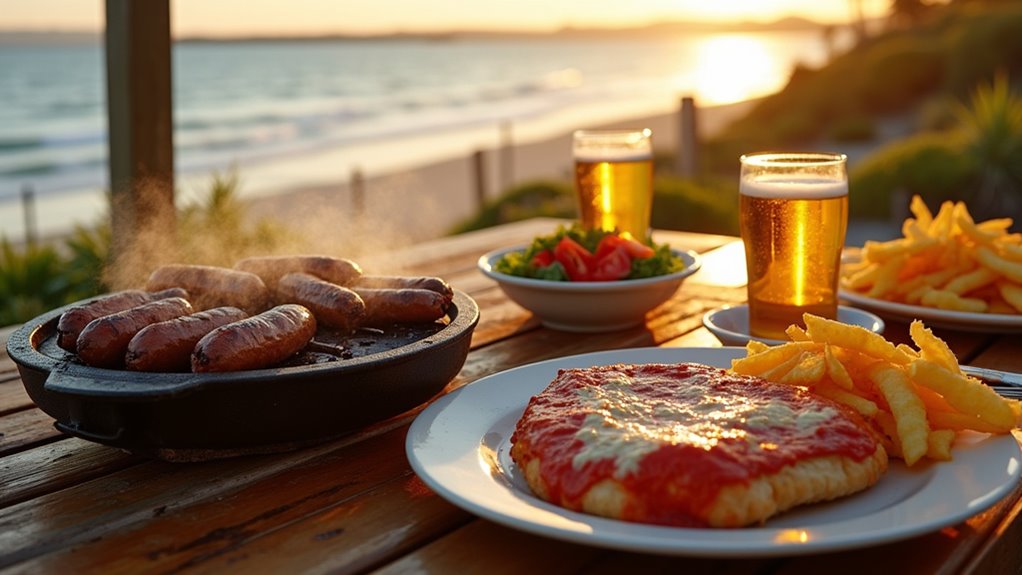
Discover Australia's unique food traditions where sizzling barbies and hearty parmas reveal cultural secrets worth savoring.
Australian BBQ culture blends 40,000-year-old Indigenous cooking traditions with European influences, centering around community and casual gatherings. You’ll find iconic foods like chicken parmas, sausage sizzles, and grilled seafood at these social events. Modern barbies feature both traditional meats and plant-based options, complemented by distinctive sides like potato salad and pavlova. Whether at backyard gatherings or fundraising events, Australian BBQs reflect the nation’s multicultural identity and relaxed social customs. Discover the full flavor below.
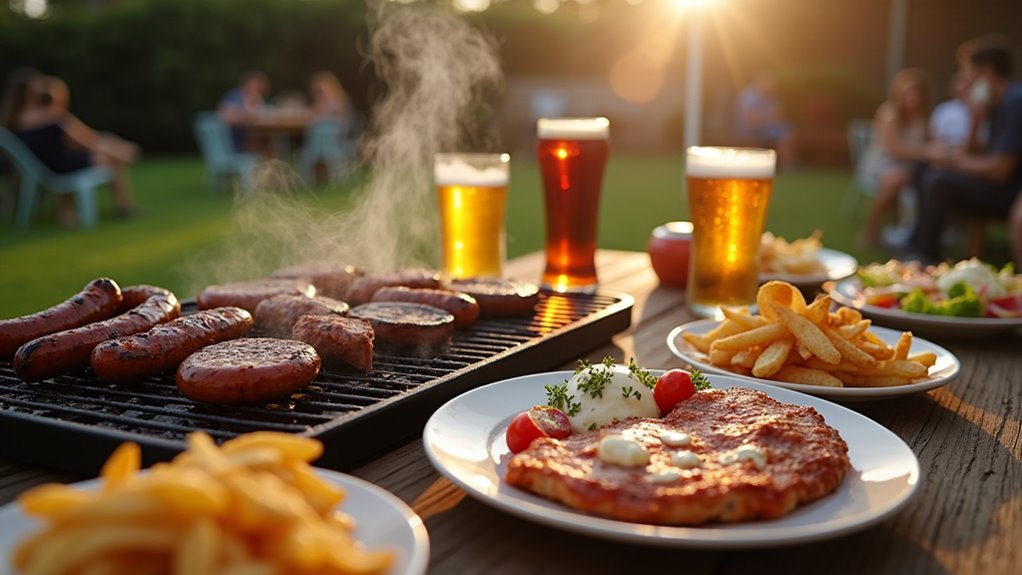
When you explore Australian food culture, you’ll quickly discover that BBQs and Parma represent core elements of the nation’s culinary identity. Both traditions showcase Australia’s blend of cultural influences and social values.
Australian cuisine centers on communal traditions that reflect the nation’s diverse heritage and laid-back social spirit.
BBQs evolved from English settlers’ outdoor cooking practices, adapting to the Australian landscape over generations. The tradition actually dates back approximately 40,000 years, originating from Aboriginal cooking practices before European settlement. By the 1960s, the “barbie” had become inseparable from Australian lifestyle, featuring staples like beef, lamb, and “snags” (sausages) cooked on flat or mesh grills.
Meanwhile, the Parma—a chicken schnitzel topped with tomato sauce, ham, and melted cheese—has become the quintessential pub meal across the country. Served with chips and salad, it reflects Italian influence on Australian cuisine. These pub classics have developed distinct regional variations throughout Australia’s different states and territories.
Together, these foods represent Australia’s casual, communal approach to dining, whether at public parks, beaches, or local pubs.
While BBQs and Parma have become staples of modern Australian food culture, the tradition of outdoor cooking in Australia runs far deeper than European settlement. Indigenous Australians pioneered outdoor cooking techniques over 40,000 years ago, using hot coals and earth ovens perfectly suited to the harsh climate.
When you’re enjoying a modern barbie, you’re participating in a cultural practice with ancient origins. Aboriginal communities developed sophisticated methods like earth oven cooking, where food was prepared in pits lined with leaves over hot stones. This community-oriented cooking style shares similarities with the geothermal cooking practiced in destinations like Rotorua.
These techniques weren’t just practical—they were social events that strengthened community bonds.
European settlers quickly learned from Indigenous practices, adapting them to their own needs while introducing new ingredients. The term “barbecue” made its first documented appearance in Australian culture during the Leg o’ Mutton Barbeque held at the Waverley Bowls Club in 1903. Today’s Australian BBQ represents a genuine fusion of these ancient traditions with modern innovations.
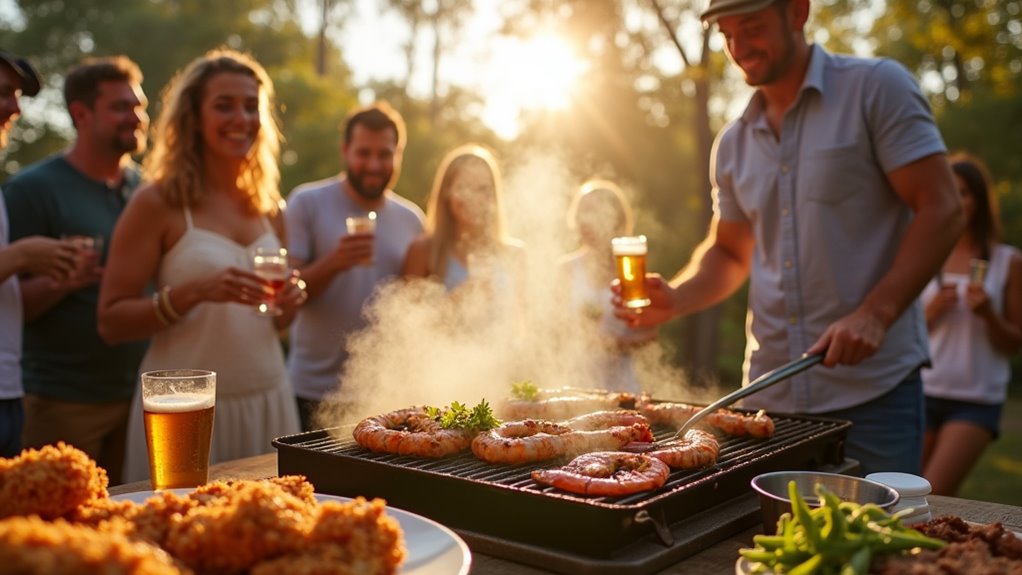
Although Australians have embraced the barbecue as an integral part of their national identity, the Aussie barbie wasn’t always the backyard staple we recognize today. The term first appeared in 1903 at Waverley Bowls Club’s Leg o’ Mutton Barbecue, but early barbecues were massive public events, not private gatherings.
You’ll find the shift from public to private occurred gradually after WWII. By the 1950s, backyard barbecues became fixtures in suburban homes, with the Australian Women’s Weekly promoting outdoor living. In 1958, Australia published its first barbecue cookbook titled The burnt offering, marking a significant milestone in barbecue culture.
The 1960s revolution of gas grills made barbecuing more convenient and accessible year-round. Safety became paramount as Australians learned to host barbecues while being mindful of dangerous animals that might be attracted to food or lurking in outdoor spaces.
Today’s barbecue reflects Australia’s multicultural fabric, featuring diverse meats, international flavors, and sustainability practices. What began as civic celebrations has evolved into the quintessential symbol of Australian social life.
As the Aussie barbie evolved from civic gatherings to backyard fixtures, a simpler, more accessible barbecue tradition was taking root across the nation. The humble sausage sizzle emerged as Australia’s quintessential community event, gaining widespread recognition in the 1980s.
You’ll find this unpretentious culinary tradition everywhere: a beef or pork “snag” grilled to perfection, nestled in a single slice of white bread, topped with caramelized onions and a squirt of tomato sauce. For a few dollars, you’ve got the perfect casual meal.
But the sausage sizzle transcends food—it’s a social institution. On election days, these become “democracy sausages,” transforming the civic duty of voting into a community celebration. The 2016 federal election saw the sausage sizzle gain international attention when even Twitter added a special sausage emoji to election-related posts.
Schools, sports clubs, and charities rely on sausage sizzles as essential fundraising vehicles, turning simple ingredients into community support. Whether you’re in east coast cities like Sydney or Brisbane, these communal gatherings bring Australians together through shared culinary traditions.
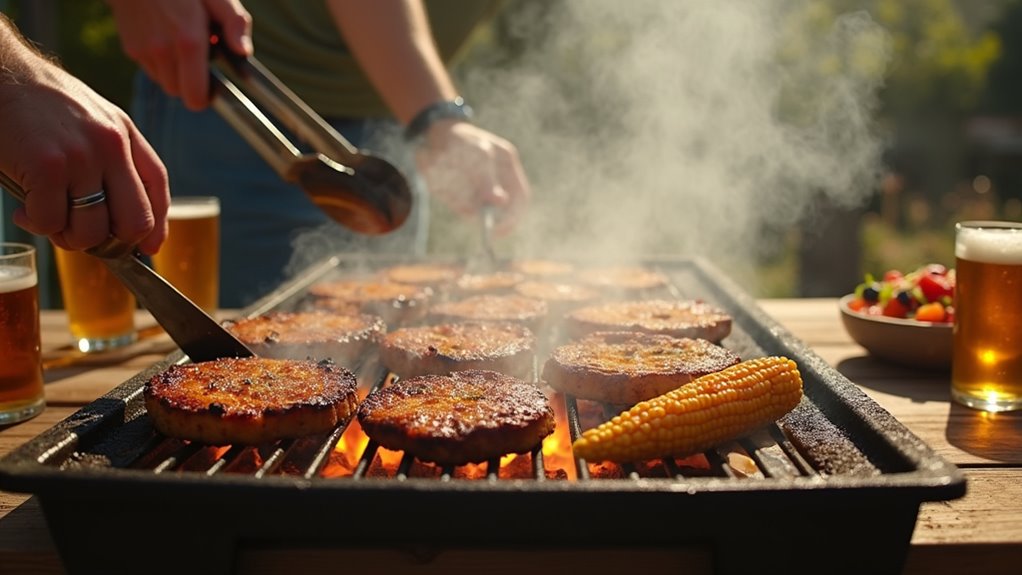
Despite what Paul Hogan’s famous 1980s tourism campaign would have you believe, Australians rarely “throw shrimp on the barbie” – they’re called prawns down under, and they’re just one small part of Australia’s diverse barbecue culture.
You’ll find “snags” (sausages) as the true BBQ staple, alongside lamb chops, beef steaks, and even kangaroo meat for a uniquely Australian touch. Seafood extends beyond prawns to grilled barramundi, squid, and octopus.
Don’t forget the vegetables – zucchini, eggplant, capsicums, and corn wrapped in foil are BBQ favorites. Australians keep seasonings simple with salt and pepper, but you’ll also encounter garlic, rosemary, and lemon for added flavor. Many authentic Australian BBQs incorporate native ingredients like wattleseed, lemon myrtle, and finger lime to add depth and authenticity to grilled dishes.
BBQs reflect Australia’s outdoor lifestyle and sense of community, bringing people together around sizzling grills at parks, beaches, and backyards nationwide. In affordable regions like Tasmania and South Australia, community BBQs have become a budget-friendly way for locals to socialize while enjoying the country’s famous cuisine.
While Australia’s BBQs offer a delicious outdoor experience, you’ll find another culinary icon waiting inside the country’s pubs. The chicken parma (or parmigiana) reigns supreme as Australia’s beloved pub food champion.
This Italian-inspired dish features breaded and fried chicken breast topped with tomato sauce and melted cheese, delivering flavorful, savory flavors in every bite. Typically containing 381-582 calories, parmas come in various sizes, from standard servings to hearty “pub size” portions. Restaurant versions can contain significantly more calories, with some options from places like The Coffee Club containing over 1300 calories per serving.
Despite its Italian-American roots, Australians have embraced the parma as their own, creating unique variations like the Chicken Parma Spud. Like New Zealand with its unique animal species, Australia has developed a distinct food identity that sets it apart from other nations.
You’ll find it’s more than just food—it’s a cultural institution that brings people together during social gatherings and sporting events, cementing its status as quintessentially Australian fare.
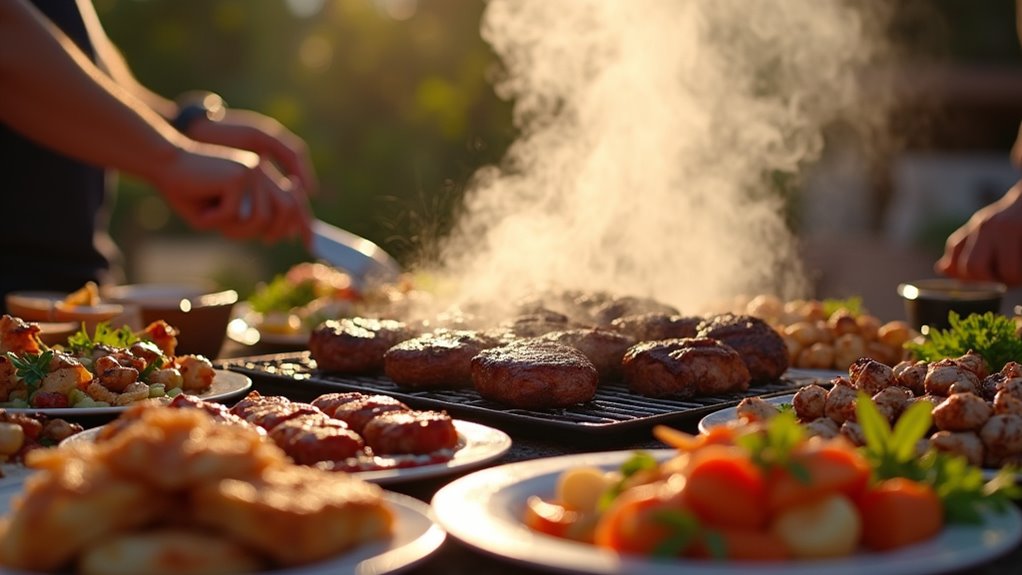
Australia’s affluent BBQ culture owes its diverse and vibrant flavors to the waves of immigration that have shaped the nation’s culinary landscape. Dating back 40,000 years with Aboriginal roots, Australian BBQ has evolved with each new cultural influence.
When you attend an Aussie BBQ today, you’ll taste Mediterranean influences in Greek marinades and Italian sausages, especially in Sydney. Middle Eastern spices and kebab techniques blend perfectly with Portuguese cooking methods and Asian flavor profiles featuring fresh herbs and spices. The addition of Vietnamese elements in the 1970s introduced fresh herb combinations that revolutionized traditional BBQ marinades.
Immigrants have adapted their traditional recipes to incorporate local ingredients, creating unique fusion dishes. Marinating meats for at least two hours allows these multicultural flavors to fully develop.
This culinary evolution represents more than food—it’s a symbol of community bonding and cultural exchange that 90% of Australians proudly embrace. While exploring culinary traditions across the country, travelers should be aware of hazardous locations in New Zealand’s neighboring landscapes if extending their food tourism journey.
From the sun-scorched outback to bustling coastal cities, regional BBQ specialties vary dramatically across Australia’s diverse landscape. You’ll notice these differences as you travel through the country’s culinary landscape.
In coastal regions, seafood dominates the grill – fresh prawns and fish often take center stage. Queensland BBQs incorporate tropical fruits, while South Australian grills might feature local olive oils and wines. Many regional Australian chefs incorporate native ingredients like bush tomato and lemon myrtle to create distinctive flavor profiles.
Each state capital puts its own spin on the traditional barbie. In Sydney, you’ll find more Asian-fusion influences, while Melbourne embraces Mediterranean flavors.
The outback offers more rustic, meat-focused affairs with slow-cooked specialties.
Farmers’ markets and regional festivals are your best opportunity to sample unique local BBQ specialties that highlight indigenous ingredients and cooking techniques specific to each area. Though Australian BBQ culture thrives regardless of the cost of living that varies across different regions of the country.
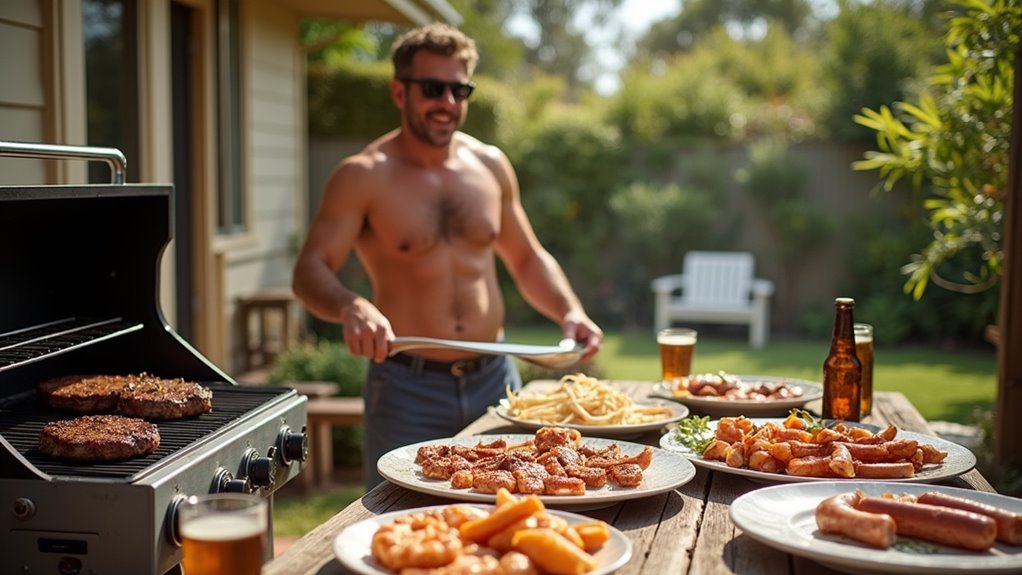
Beneath the casual atmosphere of an Australian BBQ lies a complex social code that every participant instinctively follows. You’ll be expected to bring something—whether it’s meat, salad, or drinks—as arriving empty-handed is considered poor form.
Dress casually; thongs and shorts are perfectly acceptable. Don’t hover around the grill or offer unsolicited cooking advice—this is the host’s domain. Always compliment the cooking, even for simple sausages. Keeping your phone on silent mode throughout the event shows respect and encourages genuine social interaction.
Offer to help with setup or cleanup, and be mindful about leaving the area tidy. When invited to “bring a plate,” this means bringing a dish to share, not empty dinnerware. While Australian BBQs focus on meat dishes, you might occasionally find inspiration from New Zealand cuisine with its unique flavors and cooking techniques.
Remember to socialize widely, maintain a friendly demeanor, and thank your host before departing. Leaving your leftover drinks is a thoughtful parting gesture.
When attending an Australian social gathering, you’ll likely hear the phrase “bring a plate” – a request that doesn’t mean carrying empty dinnerware, but rather contributing a prepared dish to share with everyone.
This distinctly Australian tradition reflects core values of fairness and community. You’ll find it at picnics, school events, and increasingly at dinner parties, where it distributes the hosting burden while ensuring diverse offerings.
There’s no strict menu – salads, finger foods, and desserts are all welcome. The beauty lies in the variety, often showcasing Australia’s multicultural makeup through different culinary traditions. This tradition has historically been expressed as “Ladies, bring a plate,” reflecting the gender expectations of earlier times when women were primarily responsible for food preparation.
The practice bridges generations and backgrounds, creating an inclusive atmosphere where everyone contributes according to their means, whether with homemade specialties or store-bought favorites. Much like the community spirit found in New Zealand’s Rotorua, these shared meals foster connection and create memorable experiences for all participants.
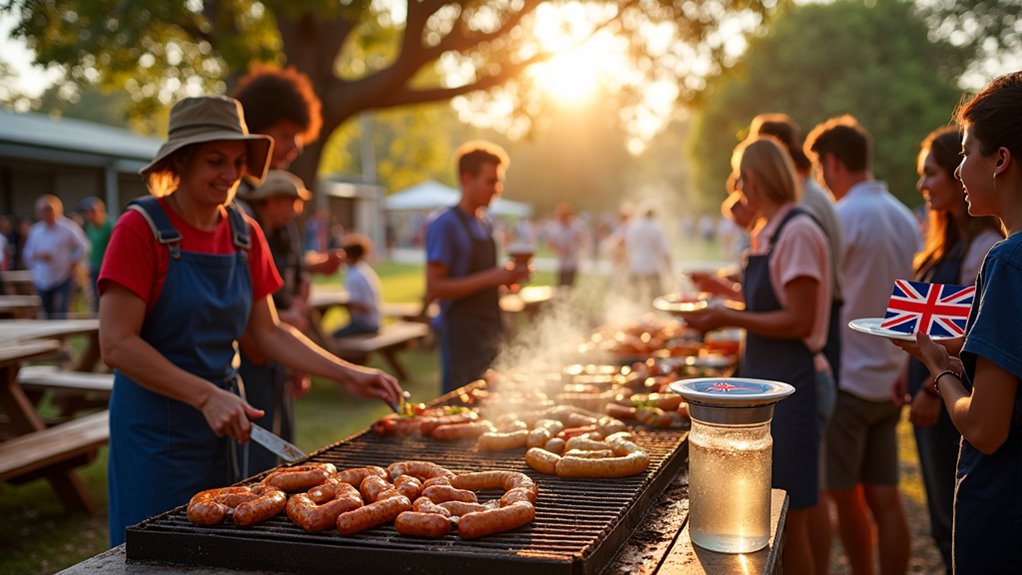
While many cultures enjoy outdoor cooking, Australians have transformed the humble BBQ into a powerful fundraising tool that supports countless community initiatives across the nation.
You’ll find BBQs at the heart of Australian fundraising culture, with the iconic Bunnings sausage sizzle alone raising over $144 million through 160,000+ events in just four years.
Each sizzle typically generates around $900, though some rake in triple that amount.
These events do more than raise funds—they foster social cohesion and community spirit.
Whether supporting the Prostate Cancer Foundation through the Big Aussie Barbie or staffing a local school fete, BBQs represent Australia’s outdoor lifestyle while creating meaningful economic impacts through food sales, donations, and volunteer engagement.
From East Coast Sydney to Perth on the West Coast, barbecue traditions unite Australians despite the vast geographical differences across the continent.
The sense of national identity is further strengthened as nearly two-thirds of households own a barbecue, making these community events both accessible and culturally significant.
Although traditional sausages and steaks still hold their place on the Australian grill, today’s BBQ scene has evolved into a sophisticated culinary experience that reflects the nation’s multicultural identity and growing food consciousness.
The humble Aussie barbie has transformed into a global flavor festival while honoring its meat-and-fire roots.
You’ll find global flavors dominating contemporary BBQs, with tandoori lamb skewers and char siu pork showcasing Australia’s culinary fusion. Just as Dunedin’s attractions draw visitors to New Zealand, Australia’s evolving barbecue culture has become a tourism highlight in itself.
Technology has transformed backyard cooking, with precision-engineered gas BBQs featuring Italian burner systems and multi-zone cooking capabilities. The Australian Barbecue Alliance organizes numerous competitions that inspire innovation in grilling techniques and flavors throughout the country.
Gourmet ingredients have become standard fare, with Wagyu beef, artisanal sausages, and native Australian spices elevating everyday grilling.
Innovative techniques like sous-vide followed by reverse searing are now common, while sustainability concerns have led to eco-friendly options such as solar-powered grills and responsibly sourced meats.
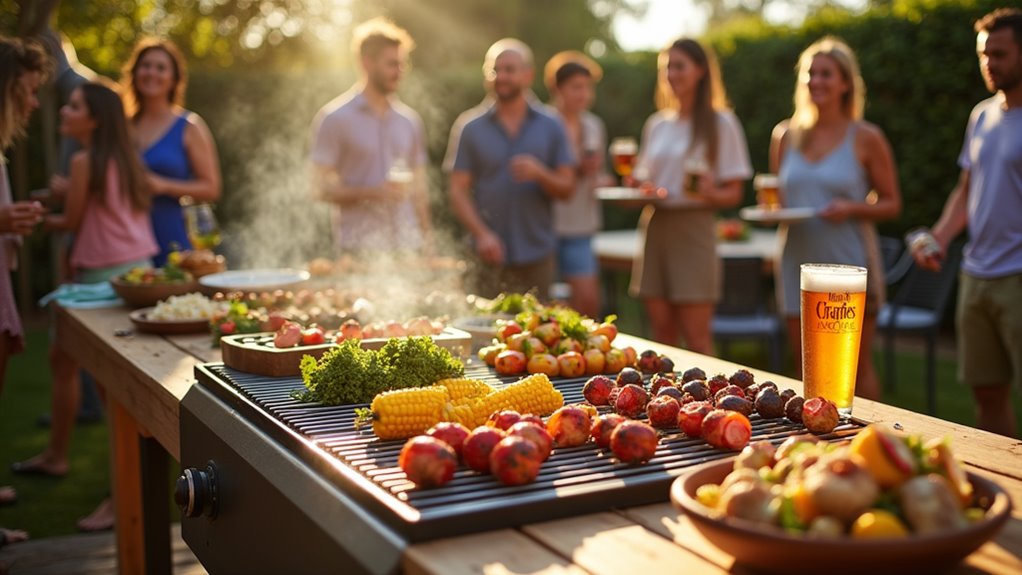
The traditional meat-centric Australian BBQ is undergoing a significant transformation as plant-based alternatives take their rightful place on the grill. You’ll find over 250 plant-based products in Australian supermarkets, with more than half made locally, reflecting growing consumer demand for meat-free options. The 1983 Meatless Barbecue Event in Sydney’s Centennial Park demonstrated that BBQs could be enjoyable without animal products. Even Queenstown culinary experts recognize that plant-based cuisine is becoming a global movement beyond Australian borders.
Next time you’re hosting a barbie, consider including these popular plant-based alternatives:
While less than two in five Australians are currently open to meat substitutions, urban areas like NSW and Victoria show higher acceptance of these eco-friendly alternatives that reduce your carbon footprint.
No Australian BBQ is complete without a stellar lineup of side dishes that complement the smoky, grilled mains. You’ll find creamy potato salads, pancetta pasta salad, and modern takes on coleslaw like miso variants at most gatherings.
For something more unique, try peach and haloumi salad or roast pumpkin with pepitas. Many Aussies serve protein-rich options like green bean, bacon, and egg salad alongside their meats. The Wild Rice, Charred Broccolini and Egg Salad offers a wonderful balance of smoky and fresh flavors that perfectly complement barbecued meats.
Don’t forget the essential dips – hummus, tzatziki, and various BBQ sauces are staples. Fresh buns and grilled bread with herbs make perfect vessels for these spreads. Unlike New Zealand where you might encounter certain cultural restrictions, Australian BBQs embrace a laid-back attitude with few social taboos regarding food customs.
To finish your meal, serve traditional desserts like pavlova or lamingtons, with cold beer, cider, or homemade lemonade to wash it all down.
You’ve now glimpsed the heart of Australian food culture, where BBQs sizzle like the soundtrack to our national identity. From indigenous roots to modern plant-based options, these gatherings are more than meals—they’re the social glue binding communities together. Whether you’re flipping snags at a sausage sizzle or debating the perfect parma, you’re not just eating; you’re participating in Australia’s ongoing culinary story.